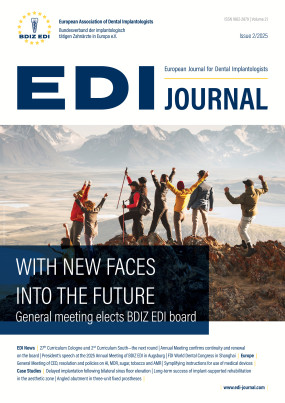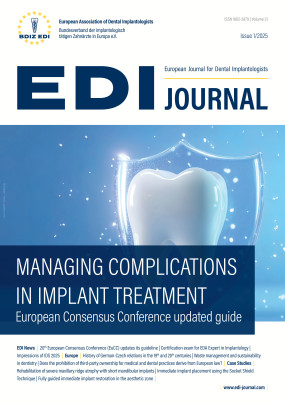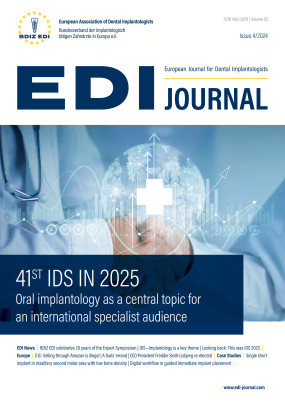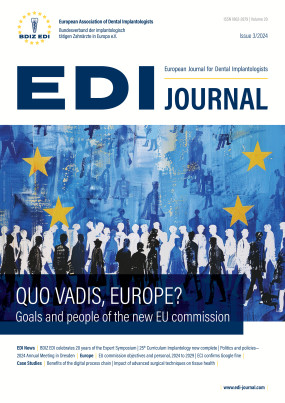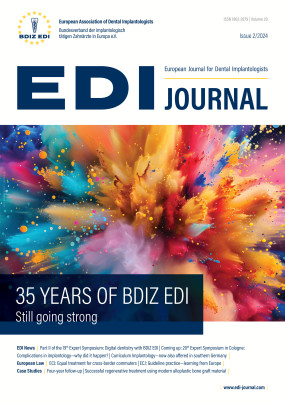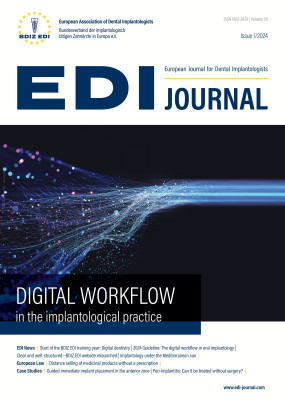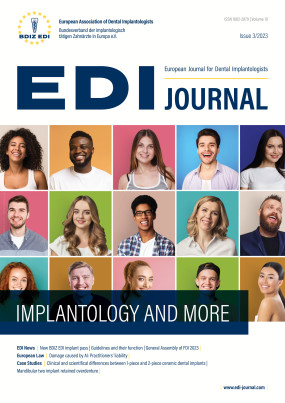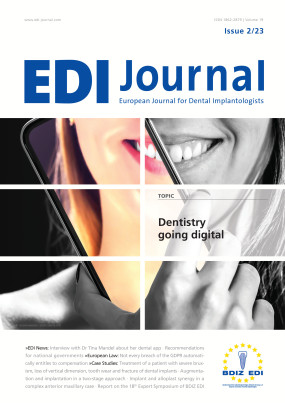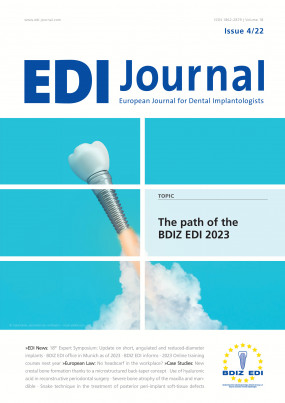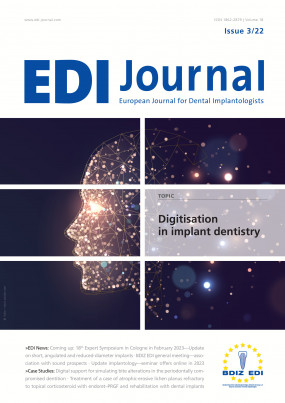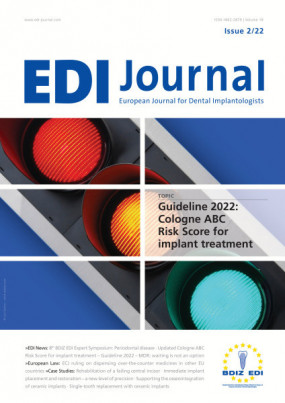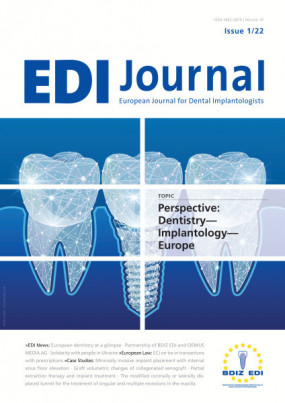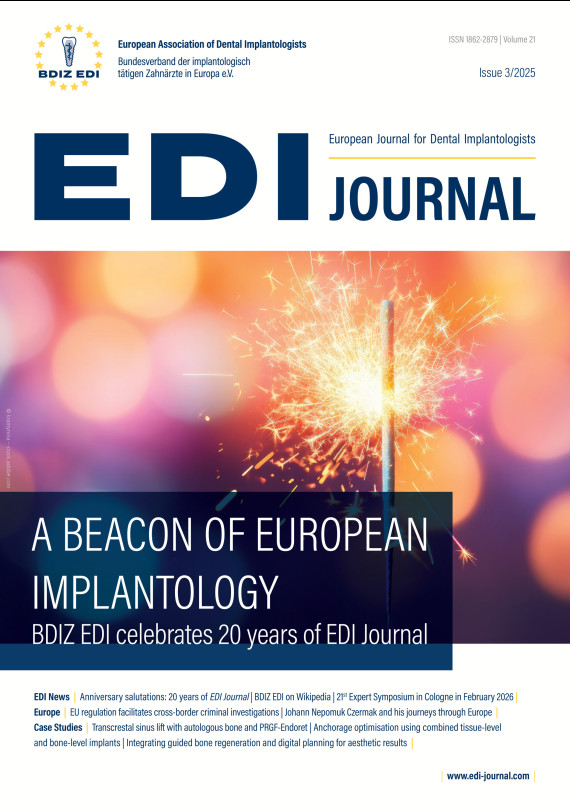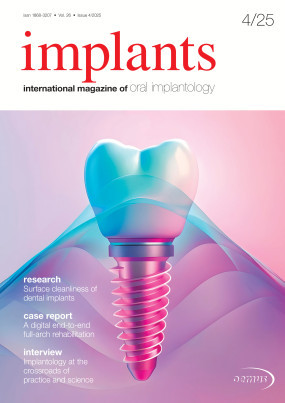Inhaltsverzeichnis
3
Editorial: Celebrating 20 years of EDI Journal—a journey of excellence, innovation, and impact
Anita Wuttke, Editor-in-Chief
wenty years ago, the EDI Journal was born from a bold vision: to create a platform that would not only chronicle the evolution of evidence-based dentistry and digital innovation, but also shape its future. Today, as we mark the 20th anniversary of this publication, I am filled with immense pride and gratitude—for the journey we’ve taken, the milestones we’ve achieved, and the community we’ve built together...
4
6
7
8
In 2025, EDI Journal—the specialist publication for implant dentistry and the English-language counterpart to BDIZ EDI konkret—celebrates its 20th anniversary. Over two decades, the journal has firmly established itself as an invaluable source of knowledge and a leading authority in European oral implantology. Published by the European Association of Dental Implantologists (BDIZ EDI), EDI Journal stands for scientific excellence, clinical relevance, and international collaboration.
10
14
18
Qualification forexperienced implantologists—Certification as an EDA Expert in Implantology
Anita Wuttke, Editor-in-Chief
For many years, BDIZ EDI has been catering to experienced and well-versed oral implantologists by offering the certification exam for EDA Expert in Implantology. Jointly with the European Dental Association (EDA), BDIZ EDI regularly invites interested dentists to take the certification exam, which we would like to present in this article.
19
In this issue, EDI Journal is launching a new section featuring practical answers to clinical questions received by the BDIZ EDI office via email or phone. This first case concerns the treatment planning of an implant for a patient who has recently been diagnosed with fibromyalgia.
20
For the past few months, the BDIZ EDI has had a dedicated entry on Wikipedia, “The Free Encyclopedia”. The article provides a comprehensive overview of the association’s history, mission and international presence. As the oldest association of its kind in Germany, the BDIZ EDI boasts an impressive range of activities that extend far beyond national borders. The entry was created by Prof. Joachim E. Zöller, a recognised Wikipedia author.
22
Fresh perspectives and proven expertise—Introducing the newly elected members of the BDIZ EDI board
Author
BDIZ EDI enters a new term with renewed energy, professional expertise, and a fresh outlook. At the general assembly held in Augsburg at the end of June, new board members were elected. The composition of the board reflects the diversity and innovative strength of dental implantologists in Europe.
24
21st Expert Symposium in Cologne in February 2026—Printing, milling, melting: Quo vadis, implantology?
Anita Wuttke, Editor-in-Chief
When expertise, innovation and a touch of Rhineland cheerfulness come together, it’s time once again for the BDIZ EDI Expert Symposium in Cologne. The theme: Printing, milling, melting—Quo vadis, implantology? On 15 February 2026, this one-day event will explore digital manufacturing technologies that are transforming implant dentistry. The day before, on 14 February 2026, BDIZ EDI will host workshops in collaboration with its industry partners.
28
Mission accomplished—Curricula Cologne and South successfully completed—time for the next round
Anita Wuttke, Editor-in-Chief
It’s a true success story: the directors of the Curriculum Implantology, in cooperation with the University of Cologne, have seen their 26th group of graduates, through to completion. They are now equipped with a solid foundation in implantology and ready for the future. Meanwhile, the Curriculum South programme has also successfully completed its first run in Munich and Ansbach. With both the Cologne and South curricula well underway, BDIZ EDI is preparing for the next round. The 27th Curriculum Cologne will begin on 28–29 November 2025 at the University of Cologne. The second round of the Curriculum South has already begun, starting on 19–20 September 2025 in Ansbach.
30
32
In its ruling of 12 June 2025, the ECJ ruled that national regulations are permissible that oblige employers to vaccinate employees if they are exposed to biological agents (e.g. SARS-CoV-2). This is based on Directives 89/391/EEC and 2000/54/EC on occupational health and safety.
34
E-Evidence on the horizon—EU regulation facilitates cross-border criminal investigations
Anita Wuttke, Editor-in-Chief
Have you heard of the EU’s E-Evidence Regulation? If not, it is time to find out more, as it could affect professionals bound by confidentiality obligations, including doctors, dentists and psychotherapists. The regulation aims to streamline the way criminal prosecution authorities in Europe obtain access to digital evidence, such as e-mails, chat logs or stored data on servers, in order to improve the investigation of serious crimes, including terrorism and cybercrime.However, there is also an ongoing debate about data protection and the rights of those affected.
37
38
The University of Sarajevo is setting the pace—A new simulation centre for education and training
Anita Wuttke, Editor-in-Chief
The Faculty of Dental Medicine and the University Dental Clinic in Sarajevo have opened a new centre for education and training and are actively seeking partners for serious cooperation in the European dental education sector.
40
Discoverer of interglobular dentin—Johann Nepomuk Czermak and his journeys through Europe
Doc. MUDr. Otakar Brázda, CSc.Prague
In 1850, Johann Nepomuk Czermak (1827–1873) completed his dissertation Observationes novae de structura dentium penitiori (New Observations on the Internal Structure of Dentin) in Würzburg, Germany. In this dissertation, he became the first to describe interglobular dentin. Today, his findings are commonly known among dental professionals as “Czermak lacunae”. While his name is familiar in dental histology, little is known about the life of this remarkable scientist, who pursued an academic career at various European universities and lived in several major cities across the continent. His life was marked by notable achievements, as well as painful setbacks.
44
The FDI World Dental Congress 2025, held in Shanghai from 9–12 September, brought together dental professionals from around the globe to address pressing challenges and innovations in oral health. Here are the key findings and highlights from the event.
46
Since June 2025, Stefanie Tiede has been a member of the extended Executive Board of BDIZ EDI, bringing the association closer to the global dialogue on oral health and dental policy through her active involvement in the Fédération Dentaire Internationale (FDI).
47
48
Transcrestal sinus lift with autologous bone and PRGF-Endoret—Long term bone volume maintenance
Dr Eduardo Anitua, Spain
In recent decades, the maxillary sinus lift technique has undergone a significant evolution, leading to a paradigm shift in the surgical approach to the atrophic posterior maxilla.1–3 Traditionally, the lateral window sinus lift was considered the method of choice for increasing subantral bone volume, particularly in cases with minimal residual bone height. However, the development of less invasive techniques, coupled with advances in implant design and a deeper understanding of osseointegration processes, has positioned the transcrestal sinus lift as a predictable, safe, and clinically efficient alternative.1–5
54
Anchorage optimisation using combined tissue-level and bone-level implants—Skeletal class III malocclusion case
Dr Carlos Gargallo Gállego, Spain
Managing skeletal class III malocclusion can be quite complex and typically requires an interdisciplinary approach to develop a comprehensive treatment plan. This condition has a multifactorial aetiology and is often associated with multiple dentoalveolar complications, including anterior and/or posterior crossbite resulting from maxillary retrognathism and mandibular prognathism, along with vertical and/or transverse problems.1 These complications can increase the patient’s sus- ceptibility to dental caries, periodontal disease, edentulism and also have psycho- social ramifications.2, 3
60
Integrating guided bone regeneration and digital planning for aesthetic results—Immediate anterior maxilla restoration
Dr Dalton Marques, Brazil
The following case report focuses on the rehabilitation of a 35-year-old male patient who presented with loose anterior teeth, a progressively widening diastema, and discomfort during eating. The patient desired a comprehensive solution to restore dental stability, improve oral function, and enhance his smile. His dental history included prior orthodontic treatment for an impacted canine, with no systemic conditions, smoking habits, or medication use influencing the treatment plan.
64
A decade of digital innovation with OneGuide—OSSTEM World Meeting 2026 Bangkok
OSSTEM Europe s. r. o.
The global dental community will gather at the Centara Grand Convention Center in Bangkok, Thailand, on 27 and 28 March 2026 for the Osstem World Meeting 2026. This prestigious event brings together clinicians, researchers, and industry leaders to share the latest academic findings, clinical experiences, and technological innovations that are shaping the future of implant dentistry and digital workflows.
65
66
“BEYOND REGENERATION” is the motto of the next International Osteology Symposium in Vienna, 23–25 April 2026. It reflects the core focus on oral tissue regeneration while broadening the view to comprehensive patient care and long-term treatment success. Vienna promises a unique learning experience, with condensed, practice-oriented knowledge delivered by world-renowned experts alongside the rising stars of tomorrow.
68
Elevating clinical dentistry through periodontal and restorative collaboration—Perio Master Clinic 2026
European Federation of Periodontology (EFP)
The European Federation of Periodontology (EFP) warmly invites oral health professionals from across the globe to attend Perio Master Clinic 2026, taking place in the vibrant and culturally rich city of Baku, Azerbaijan, on 6 and 7 March 2026. The 2026 edition will focus on the Perio-Restorative Interplay, underscoring the essential collaboration between periodontal and restorative disciplines in achieving outcomes that are not only predictable but also aesthetically refined and long-lasting—even in the most complex clinical situations.
70
To mark the 30th anniversary of TIOLOX®/tioLogic® implantology at Dentaurum, the focus of tioLogic® TWINFIT is on a state-of-the-art, high-quality look that combines proven clinical reliability with innovative connection technology. The unique connector geometry, with a choice between cone and platform, allows maximum flexibility in prosthetic restoration—while maintaining a stable connection at the same time. As a result, Dentaurum sets new standards for precise, long-lasting, and efficient implant solutions—both in everyday practice and laboratory work.
71
OSSTEM Smart choices in regeneration: versatile biomaterials for reliable results In dental regeneration, predictability and efficiency are key. With a growing demand for versatile, evidence-based solutions, OSSTEM offers a comprehensive portfolio of biomaterials designed to support successful bone and soft-tissue regeneration in various clinical scenarios. A-Oss is a naturally derived xenograft made from bovine bone. Its slow resorption profile ensures long-term volume stability, making it ideal for ridge preservation, sinus lifting, and larger defect reconstructions. Its osteoconductive properties promote rapid integration with the host bone, providing a reliable scaffold for new bone formation.
72
Traditional implant workflows require multiple components—healing abuments, impression posts, scanbodies—all of which involve placing, removing, and replacing parts across multiple visits. This not only consumes time and may increase the risk of errors and biological complications...
73
The ZM10 implant system by Ziacom is a high-performance conical connection implant designed to meet clinical demands for surgical precision, mechanical strength, and biological compatibility. It integrates a prosthetic-level conical connection with a unique macro and micromorphological body, enabling optimal primary stability, reduced crestal stress, and predictable long- term outcomes

